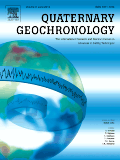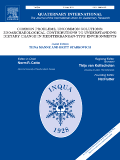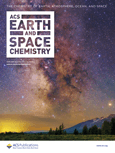
RADIOCARBON
metrics 2024
Charting New Discoveries: The Essential Resource for Scholars
Introduction
RADIOCARBON, published by Cambridge University Press, is a premier academic journal that has been pivotal in advancing the fields of Archeology and Earth and Planetary Sciences. With an impressive impact factor placing it in the Q1 category of both disciplines, it ranks 1st out of 413 in Archeology and 6th out of 195 in General Earth and Planetary Sciences. As a trusted source for significant research findings, the journal spans the years from 1980 to 2024, offering a robust archive of scholarly articles. Although it does not currently provide Open Access options, it remains a vital resource for researchers, professionals, and students eager to explore innovative studies and applications in radiocarbon dating and its implications within the broader scientific landscape. The journal’s headquarters in Cambridge, England, solidifies its reputation as a key player in the academic community, fostering rigorous scientific discussions and discoveries.
Metrics 2024
 4.96
4.96 2.00
2.00 4.60
4.60 92
92Metrics History
Rank 2024
Scopus
IF (Web Of Science)
JCI (Web Of Science)
Quartile History
Similar Journals

Quaternary Geochronology
Decoding the Past: The Science of Quaternary Dating.Quaternary Geochronology is a leading journal published by Elsevier Ltd, specializing in the field of Earth and Planetary Sciences. With a strong emphasis on the geochronological methods and techniques used to date geological materials from the Quaternary period, this prestigious journal serves as a critical platform for disseminating significant research findings, theoretical advancements, and comprehensive reviews relevant to the stratigraphic and geological sciences. Since its inception in 2006, the journal has garnered an impressive impact factor, positioning itself in the Q1 category for its excellence in Earth and Planetary Sciences, Geology, and Stratigraphy. Quaternary Geochronology currently ranks #11 out of 55 in Stratigraphy, #74 out of 321 in Geology, and maintains a high standing across various related fields. Researchers, professionals, and students are encouraged to explore its rich archives and current issues for the latest trends, methodologies, and findings that shape our understanding of Quaternary environments. The journal does not operate under an open-access model, ensuring that high-quality peer-reviewed research is accessible while maintaining rigorous academic standards.

Kratkie Soobshcheniya Instituta Arkheologii
Exploring the Depths of History and ArchaeologyKratkie Soobshcheniya Instituta Arkheologii is a prestigious academic journal published by IZDATELSTVO NAUKA, specializing in the fields of archaeology and history. With an ISSN of 0130-2620, this journal has established itself as a vital resource for scholars, researchers, and students engaged in the humanities, particularly within the Russian Federation. Recognized for its high-quality contributions, it has achieved a remarkable Q1 ranking in both Archaeology and History for the year 2023, demonstrating its significant impact and relevance in these disciplines. Although it does not provide open access, the journal's robust positioning in Scopus — ranking #634 in History and #208 in Archaeology — further attests to its scholarly authority and the insightful research it disseminates. The journal covers a comprehensive range of topics, facilitating a deeper understanding of archaeological practices and historical methodologies, thereby fostering academic dialogue and knowledge advancement from 2018 through 2024. Addressing an international audience of professionals and students alike, Kratkie Soobshcheniya stands as a cornerstone for innovative research in archaeology and history.

QUATERNARY INTERNATIONAL
Unveiling the Secrets of Geological Change.Quaternary International is a prestigious journal published by Pergamon-Elsevier Science Ltd, focusing on the interdisciplinary study of the Quaternary Period, which encompasses significant geological, hydrological, and climatic changes. With an ISSN of 1040-6182 and E-ISSN 1873-4553, it stands as a critical resource in the realm of Earth-Surface Processes, achieving a strong position within the academic community, evidenced by its 2023 Scopus rank of #32 out of 179 in this category, corresponding to an impressive 82nd percentile. Since its inception in 1989, this journal has provided valuable insights and contributed to the advancement of knowledge in the Earth and Planetary Sciences. Researchers, professionals, and students alike will find a wealth of original research articles, reviews, and case studies that inform and inspire further studies in the Quaternary sciences. Although the journal does not currently offer open access options, its reputation for rigorous peer review and impactful content underscores its significance in shaping scholarly discourse in the field.

Zephyrus-Revista de Prehistoria y Arqueologia
Championing Cutting-Edge Research in ArchaeologyZephyrus-Revista de Prehistoria y Arqueologia, published by UNIV SALAMANCA, EDICIONES, is a renowned academic journal dedicated to the fields of archaeology and prehistory. Since its inception in 1950, the journal has embraced an Open Access model, facilitating widespread access to cutting-edge research and scholarly discourse while fostering global collaboration among researchers. Based in Salamanca, Spain, this journal has achieved remarkable recognition, evidenced by its Q1 rankings in Archaeology and History as of 2023, and impressive Scopus standings across various categories, including an 83rd percentile in History. The journal's comprehensive scope since 2011 has made it a vital resource for academics seeking to deepen their understanding of human history through archaeological insights. Zephyrus not only provides a platform for disseminating innovative research findings but also serves as a bridge between historical scholarship and contemporary archaeological practices, ensuring that researchers, professionals, and students alike have access to the latest developments in the field.

Revista de Teledeteccion
Bridging theory and practice in Earth sciences.Revista de Teledeteccion, published by UNIV POLITECNICA VALENCIA, EDITORIAL UPV, is a leading Open Access journal dedicated to the interdisciplinary field of remote sensing and its applications. Since its inception in 2010, this journal has provided a vital platform for researchers, professionals, and students to disseminate groundbreaking findings, foster collaboration, and engage with contemporary challenges in Earth and Planetary Sciences as well as Geography, Planning, and Development. With a Q3 ranking in both fields as of 2023, it serves as an essential resource for advancing knowledge and innovative practices in hi-tech remote sensing methodologies. The journal covers a broad spectrum of topics, from satellite imaging techniques to environmental monitoring, making it an invaluable asset for those interested in harnessing remote sensing technologies to address real-world issues. The editorial office is located in Valencia, Spain, and the journal aims to bridge the gap between theoretical research and practical application, enriching the scientific community's understanding and capabilities in this dynamic domain.

EARTH AND PLANETARY SCIENCE LETTERS
Fostering Scholarly Dialogue on Planetary ProcessesEARTH AND PLANETARY SCIENCE LETTERS, published by ELSEVIER, stands as a premier academic journal in the fields of Earth and Planetary Sciences, Geochemistry and Petrology, Geophysics, and Space and Planetary Science. Since its inception in 1966 and continuing to 2024, the journal has consistently maintained an impressive reputation, ranking in the top quartile (Q1) across several categories, highlighting its vital role in advancing scholarly research. With a Scopus ranking of #4 in both Geophysics and Geochemistry and Petrology, and a notable 97th percentile in multiple Earth sciences categories, EARTH AND PLANETARY SCIENCE LETTERS provides a platform for groundbreaking research, encouraging rigorous investigation and dissemination of knowledge. While not available as an Open Access publication, the journal remains highly accessible to academics and professionals worldwide, providing invaluable insights and fostering discussions that influence the future of Earth sciences. Whether you are a researcher, educator, or student, this journal is a crucial resource for understanding our planet and its processes.

ACS Earth and Space Chemistry
Innovating Solutions for Planetary Challenges through ChemistryACS Earth and Space Chemistry is a leading journal published by the American Chemical Society, dedicated to advancing the interdisciplinary fields of atmospheric science, geochemistry, and planetary science. Since its inception in 2017, this journal has quickly established itself as a pivotal resource for researchers and professionals, boasting an impressive impact factor and securing its position in Q2 of the Scopus rankings for 2023 across its relevant categories. The journal publishes cutting-edge research articles, reviews, and commentaries that explore the chemical processes influencing Earth and space environments. By providing open access to invaluable research from experts around the globe, it encourages collaboration and dissemination of knowledge, crucial for addressing pressing environmental and planetary challenges. Situated in the heart of Washington, D.C., the journal's editorial office works diligently to ensure rigorous peer review and high-quality publications that meet the needs of its diverse audience, including scholars and students keen to stay abreast of developments in these dynamic fields.

Frontiers of Earth Science
Elevating Earth Science Research to New HeightsFrontiers of Earth Science is a prominent academic journal in the field of Earth and Planetary Sciences, published by Springer. With an ISSN of 2095-0195 and an E-ISSN of 2095-0209, this journal serves as a significant platform for researchers and professionals to disseminate their findings from 2007 to 2024. It is recognized for its impactful contributions within the category of Earth and Planetary Sciences, boasting a respected Q2 ranking in 2023. With a Scopus ranking of 64 out of 195, placing it in the 67th percentile, Frontiers of Earth Science continues to drive academic dialogue and innovation. The journal is dedicated to exploring a diverse range of topics, including geology, meteorology, and environmental science, and amplifying the understanding of Earth systems through rigorous research. Located in New York, USA, this journal embraces an Open Access model, ensuring that groundbreaking research is readily available to the global scientific community, thereby enhancing its accessibility and impact.

INTERNATIONAL JOURNAL OF EARTH SCIENCES
Innovating Earth Science Research for TomorrowINTERNATIONAL JOURNAL OF EARTH SCIENCES, published by Springer, is a leading journal in the field of Earth and Planetary Sciences, distinguished by its Q1 quartile ranking in the 2023 category of Earth and Planetary Sciences (miscellaneous). With an ISSN of 1437-3254 and an E-ISSN of 1437-3262, this journal has been a pivotal platform for researchers, academics, and practitioners since its inception in 1996. The journal's focus encompasses a broad range of topics within Earth sciences, making it a vital resource for contributions that enhance our understanding of geological processes, climate change, and planetary dynamics. The impact factor reflects its high standards and the significance of the research it publishes, ranking it in the 74th percentile among its peers as per Scopus. Furthermore, the journal offers Open Access options, facilitating the global dissemination of groundbreaking research. The editorial team is committed to advancing knowledge in Earth sciences, serving as an essential reference for students and professionals looking to engage deeply with this dynamic field.

All Earth
Navigating the Complexities of Earth and SocietyAll Earth is an esteemed open-access journal published by Taylor & Francis Ltd, dedicated to multidisciplinary research in the fields of Earth and Planetary Sciences, Global and Planetary Change, as well as Management, Monitoring, Policy, and Law. Since its inception in 2021, All Earth has swiftly positioned itself in the academic community, achieving notable rankings such as Q2 in Earth and Planetary Sciences and Q3 in related fields, showcasing its commitment to high-quality interdisciplinary scholarship. Researchers and professionals can benefit from its accessible content, which contributes to the ongoing discourse on critical environmental issues and innovative solutions for sustainable development. The journal is based in the United Kingdom and continues to be a vital source of information and inspiration for students and scholars aiming to tackle the pressing challenges of our planet through rigorous scientific inquiry and policy analysis.